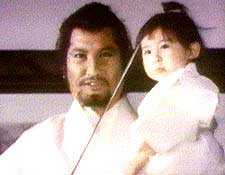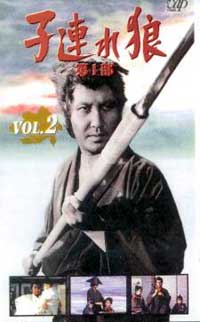The first two episodes of Kozure Okami are stand-alone adventures that do not necessarily address the subject matter of the feature films, which in large part chronicled the ongoing grudge between ex-shogunate decapitator Ogami Itto & the Yagyu clan which orchestrated his downfall. In the beginning of episode three, Kou-bashi Bridge, Itto is attacked by Yagyu spies clad as monks, suddenly placing us in territory perhaps too familiar from the films & original manga.
 Daigoro scowls unhappily as the false monks are slain by his dad. When a gunner aims straight at Daigoro, a stranger leaps in front of the bullet to save the boy. He dies in Ito's arms, with Itto expressing gratitude for saving his son, & the dying man requesting that Itto tell his wife what became of him. Daigoro scowls unhappily as the false monks are slain by his dad. When a gunner aims straight at Daigoro, a stranger leaps in front of the bullet to save the boy. He dies in Ito's arms, with Itto expressing gratitude for saving his son, & the dying man requesting that Itto tell his wife what became of him.
Alas, Itto has slaked his thirst with water poisoned by the Yagyu, & lays ill for several days while little Daigoro protects him & tries to feed him fish that Daigoro has personal caught & prepared. When passersby on the bridge above see the boy fishing at the riverside several days running, they are impressed with the three-year-old's industriousness & stoicism. One observer notes, "He's just a tiny boy, & yet he's such a man."
A couple, still grieving for the loss of a son of their own, decide to check on the boy & find out why he's always alone. They discover his father lies deathly ill in a nearby hut cared for by the bold small lad.
Ito rouses himself from his sick bed. He has still to live up to his promise to inform a fallen man's wife of his death. He instructs Daigoro to wait for him at the hut, & staggers away toward town, where he is caught up in considerable adventure, has some trouble convincing a woman that her husband really is dead, & is attacked by paranoid government officials who think he is a shogunate spy, as well as by Yagyu men.
Meanwhile Daigoro has his independent adventure by the river. The grieving couple see him alone day by day & begin to hope his father will never return so that they can adopt him. Twice they take Daigoro to their home & give him toys & pamper him & dress him up & feed him. Both times, at first opportunity, he leaves behind all their gifts & fine clothing & returns to the riverside hut to await his father.
In the last Yaguy attack, Itto takes an arrow in the chest & leg, for he is still not fully recovered from having been poisoned & lacks his usual swiftness. Even sick & wounded, he rises up invincibly to take out the Yagyu. And as we never doubted, he makes it back to Daigoro to fall on his knees upon the bridge & hug his beloved son.
 The fourth episode The Highway of Assassins is mainly a long flashback while Itto remembers three years earlier when he & Daigoro first set out on the road to hell. The fourth episode The Highway of Assassins is mainly a long flashback while Itto remembers three years earlier when he & Daigoro first set out on the road to hell.
This is the familiar manga story & first feature film story of Ogami Ito's high position as a decapitor of daimyo (lords) in service of the Shogun; of the birth of Daigoro & Ito's family life generally. It's the story of how the Yagyu successfully conspired against him so that he fell from the Shogun's grace; how everyone in his household was assassinated except Daigoro who was hidden in a closet.
It's a strong story but this version sqeezed into 45 minutes is like a condensation of the first film in the Babycart series, Lone Wolf & Cub: Sword of Vengeance (1972). By & large the television episodes & Kinnosuke's performance as Ogami Itto are second to none, but this treatment of "origin" of the Lone Wolf with cub is like an echo of Tomisaburo Wakayama's defining portrait in the first of six feature films.
The famous scene when Itto gives his son a choice to crawl toward a toy ball, or a sword, is recreated. If he selects the ball, Itto will kill him so that he can join his mother. If he selects the sword, then he will accompany his father on the hellish road of an assassin for hire.
 When officials come to read the command that Itto & Daigoro commit seppuku, father & son are already dressed in the white garments of men ready to take their own lives. The official praises Itto for having prepared himself in advance to slit open his own belly, but Itto raises his bowed face with laughter, announcing that the white garments are to celebrate his & his sons new life as assassins. And all hell breaks loose. When officials come to read the command that Itto & Daigoro commit seppuku, father & son are already dressed in the white garments of men ready to take their own lives. The official praises Itto for having prepared himself in advance to slit open his own belly, but Itto raises his bowed face with laughter, announcing that the white garments are to celebrate his & his sons new life as assassins. And all hell breaks loose.
During this episode we get a chance to see Kinnosuke Yorozuya at his most extravagant scenery-chewing. Itto as an assassin is radically stoic, but back when he was an employed family man, Kinnosuke's interpretation would have him be emotional.
When he discovers his wife Hatomi & all his household slain, Ito's emotions flare up in horror & grief & confusion. Though Tomisaburo Wakayama would never have played it this way, Kinnosuke is his own actor, & has assumed in his interpretation that Ito's silent stoicism existed only after his rebirth on the road to hell.
The climactic choreography is awesome considering it was designed for the small screen. Itto avenges his family with his Suio or Seagull sword style, including another familiar scene, when Itto takes a stance while standing in a river, with his sword held under water.
When the flashback ends, we find Itto & Daigoro three years later, when Itto is hired to kill four Yagyu spies who are troubling a local daimyo. One of them was the very man who killed Ito's wife.
copyright © by Paghat the Ratgirl
|

 Daigoro scowls unhappily as the false monks are slain by his dad. When a gunner aims straight at Daigoro, a stranger leaps in front of the bullet to save the boy. He dies in Ito's arms, with Itto expressing gratitude for saving his son, & the dying man requesting that Itto tell his wife what became of him.
Daigoro scowls unhappily as the false monks are slain by his dad. When a gunner aims straight at Daigoro, a stranger leaps in front of the bullet to save the boy. He dies in Ito's arms, with Itto expressing gratitude for saving his son, & the dying man requesting that Itto tell his wife what became of him.
 When officials come to read the command that Itto & Daigoro commit seppuku, father & son are already dressed in the white garments of men ready to take their own lives. The official praises Itto for having prepared himself in advance to slit open his own belly, but Itto raises his bowed face with laughter, announcing that the white garments are to celebrate his & his sons new life as assassins. And all hell breaks loose.
When officials come to read the command that Itto & Daigoro commit seppuku, father & son are already dressed in the white garments of men ready to take their own lives. The official praises Itto for having prepared himself in advance to slit open his own belly, but Itto raises his bowed face with laughter, announcing that the white garments are to celebrate his & his sons new life as assassins. And all hell breaks loose.